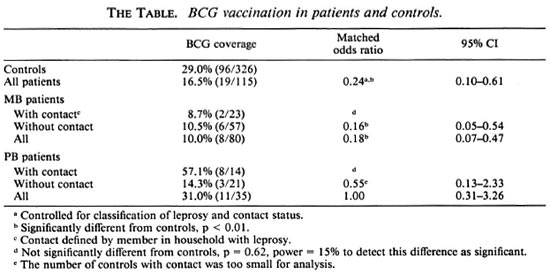- Volume 63 , Number 3
- Page: 456–7
Protective effect of BCG against leprosy in South Sulawesi, Indonesia
To the Editor:
A protective role of BCG against leprosy has been documented in several areas in the world (1). As yet, there have been no studies reported from Indonesia. We conducted a case-control study in South Sulawesi Province of Indonesia, an area with a registered leprosy prevalence of 13 per 10,000. Home visits were made to 115 children (< 15 years) with known leprosy. An experienced leprosy control officer confirmed the diagnosis of the patients and the classification into paucibacillary (PB) or multibacillary (MB) leprosy, using the criteria recommended by the Indonesian Ministry of Health (i.e., patients with six or more characteristic lesions are MB; others are PB). Two health workers assessed independently the presence of a BCG scar on the deltoid area of the patients and of 326 controls living in the same neighborhood, who were matched for sex, age, and place of birth.
The presence of a household member with leprosy should be considered a risk factor for the development of leprosy. Patients and controls were asked whether any members of their households had ever been diagnosed with leprosy. The information on leprosy in household members was also verified by checking the patient card.
BCG vaccination gave an overall protection, calculated as (1 - OR) x 100%), against leprosy of 76% [95% Confidence interval (CI) = 39%-90%; matched analysis, controlled for type of leprosy and contact status, p = 0.003]. Analysis of the data separately for MB and PB patients showed a protective effect of BCG vaccination for MB disease (OR = 0.18) but not for PB disease (OR = 1) (The Table).

However, further analysis of the data leads us to postulate that BCG vaccination also protects against PB disease, but that this protection is masked because of the design of the study. Firstly, we observed that PB patients with a case of leprosy among their households appeared to have a high vaccination coverage of 57.1% (8/14). The vaccination of PB patients without leprosy in their households was only 14.3% (3/21). The difference did not reach a significant level (Mantel-Haenszel, controlled for age, p = 0.09), but this could be due to the small numbers involved. Secondly, we found that the BCG vaccination status influenced the development of the type of disease in patients. In the BCG-vaccinated patient group who had a MB leprosy patient in their households, 71% (5/7) acquired PB disease compared to 23% (6/26) in the nonvaccinated patients of this group (p = 0.027). Six patients had a PB patient in the household: three of them were BCG vaccinated and developed PB disease; three were not BCG vaccinated and developed MB disease.
These observations suggest that after exposure to leprosy through a household member, a BCG-vaccinated person may develop the paucibacillary form rather than the multibacillary form of the disease. Then, in these cases, the number of PB patients with BCG vaccination will be increased.
Our results are consistent with the theory that BCG vaccination brings about a shift in the immune response to a higher level of cell-mediated immunity and, thereby, offers protection especially against the more severe multibacillary form of the disease (2). When this phenomenon is operative, case-control studies on the protective effect of BCG vaccination on PB leprosy could suggest that there is no effect when, in fact, thereis an important effect, BCG shifting the potential MB patients in the direction of theclinically less severe PB form. Other retrospective studies on the possible protective effects of BCG immunization against leprosy should take this point into consideration.
- Jaap Jan Boclens
Medical Faculty
- Robert Kroes
Medical Facility
State University Utrecht
The Netherlands
- Stella van Beers, M.Sc.
Medical Faculty
University of Amsterdam
Amsterdam, The Netherlands
- Peter Lever, M.D., M.Comm.H.
Health Care and Disease Control
Royal Tropical Institute
135 Wihautstraat
1097 DN Amsterdam
The Netherlands
REFERENCES
1. Fine, P. E. M. and Rodrigues, L. C. Modern vaccines; mycobacterial diseases. Lancet 335(1990)1016-1020.
2. Muliyil, J., Nelson, K. E. and Diamond, E. L. Effect of BCG on the risk of leprosy in an endemic area: a case-control study. Int. J. Lepr. 59(1991)29-236.
Reprint requests to Dr. Lever.